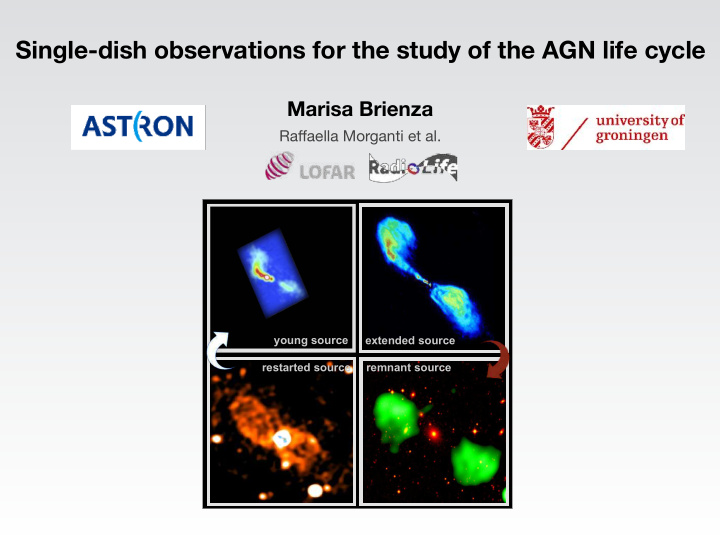



Single-dish observations for the study of the AGN life cycle Marisa Brienza Ra ff aella Morganti et al. young source extended source restarted source remnant source
WHY? • Radio galaxy evolution (radiative and dynamical) • Timescales of jet active and inactive phase • AGN radio feedback Need for bigger samples!
HOW? courtesy of M. Murgia S ∝ ν -α Radio spectrum SYNCHROTRON + INVERSE COMPTON + EXPANSION
LOw Frequency ARray
LOw Frequency ARray LOW FREQUENCY HIGH SENSITIVITY RESOLUTION 100 uJy/beam @ 6” @ 150 MHz S ∝ ν -α 6” @ 150 MHz
LOFAR discovery of a 700-kpc remnant radio galaxy at low redshift Brienza+2017,A&A,606,A98 4 mJy arcmin -1 at 1.4 GHz ~15’ interacting early type galaxies outside cluster!
LOFAR discovery of a 700-kpc remnant radio galaxy at low redshift Brienza+2017,A&A,606,A98 no ultra-steep spectral index at MHz frequencies but sudden steepening above 1.4 GHz! LOFAR WENSS 1000 α =0.5 Flux Density (m Jy) WSRT α =0.9 s l e d o m ) n 4 o 9 i 9 t u 1 v l o o v n e a 100 b e v u i G t a & α =1.6 i d v N a o r r O a s s r y i m M GB6 o K 5 1 ( + F F O r y M 0 6 10 100 1000 10000 Frequency (MHz)
The duty cycle of the radio galaxy B2 0258+35 Brienza+2018 submitted A&A CSS, Giroletti+05 250 kpc 1.4 mJy arcmin -1 at 1.4 GHz Shulevski+2012
LOFAR HBA 150 MHz @ 1.2’ α 150-1400=0.48
LOFAR Sardinia radio telescope HBA 150 MHz @ 1.2’ 6.6 GHz @ 2.9’ α 150-1400=0.48 α 1400-6600=0.69
LOFAR Sardinia radio telescope HBA 150 MHz @ 1.2’ 6.6 GHz @ 2.9’ α 150-1400=0.48 α 1400-6600=0.69 The large scale jets are still active or they have switched o ff less than few tens of Myr ago. In situ particle acceleration processes can also play a role
LOFAR Sardinia radio telescope HBA 150 MHz @ 1.2’ 6.6 GHz @ 2.9’ α 150-1400=0.48 α 1400-6600=0.69 ! t s e u q e g n a r c i m a n y d ! h d g e i r h i u o q t e e r u n d o i E t u G l N o v A n L o L c A e H D C The large scale jets are still active or they have switched o ff less than few tens of Myr ago. In situ particle acceleration processes can also play a role
NEXT STEPS…
The LOFAR Lockman Hole at 150 MHz 35 deg^2 14”x18” 23 Remnant radio galaxy 0.75 mJy/beam selected with different methods: Mahony+2016 ultra-steep spectral index spectral curvature morphology core prominence By using low frequency and multiple selection criteria the fraction of remnant radio galaxies remains low! Brienza+2017, A&A, 606, A98 Restarted radio galaxies search in progress!! (Jurlin et al. in prep)
The LOFAR Two-metre Sky Survey (LOTSS) HETDEX Spring Field , 161 < RA < 231 degrees and 45.5 < DEC < 57 degrees 6” - 20” resolution with 0.1-1 mJy/beam noise (Shimwell et al. in prep) more remnant and restarted RG to be selected soon!
Take away message! Observations at MHz frequencies are ideal to identify remnant plasma from past jet activity phases both in remnant and restarted radio galaxies BUT Observations at frequencies higher than 1.4 GHz with high sensitivity to large scale emission are essential to study the physics of the remnant plasma SINGLE DISH OBSERVATIONS!! deconvolution algorithms important for the study of restarted sources where di ff use lobes are associated to compact bright cores!
Recommend
More recommend